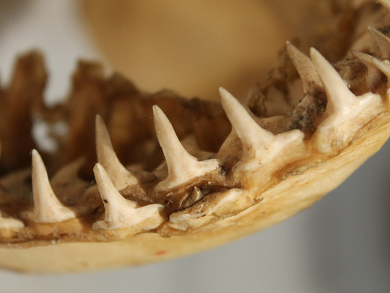Enamel, the hardest vertebrate tissue, is built on a protein matrix. Enamel probably originated in primitive fish, but until now, no one knew whether it first appeared in their teeth or scales.
Per Erik Ahlberg, Uppsala University, Sweden, and colleagues searched for enamel matrix protein genes in the recently sequenced genome of the spotted gar, and they identified a cluster of genes related to hard tissues. Sharks lack both enamel and the genes that code for the matrix proteins. Bichirs, gars, and many types of fossil fish have scales and dermal bones covered with an enamel-like substance called ganoine. Andreolepis, a fossil fish, had enamel on its scales but not the skull bones. Its descendant Psarolepis had enameled scales and skull bones, but no tooth enamel, suggesting that tooth enamel appeared later in the evolutionary process.
The genetic evidence suggests that ganoine and enamel share genetic origins, but the sharks’ enameloid material has a different origin. The researchers claim that enamel tissue must have evolved in the group that includes modern bony fish and their common ancestors, which all have tooth enamel, dermal enamel/ganoine, and enamel-generating genes.
- New genomic and fossil data illuminate the origin of enamel,
Qingming Qu, Tatjana Haitina, Min Zhu, Per Erik Ahlberg,
Nature 2015.
DOI: 10.1038/nature15259




